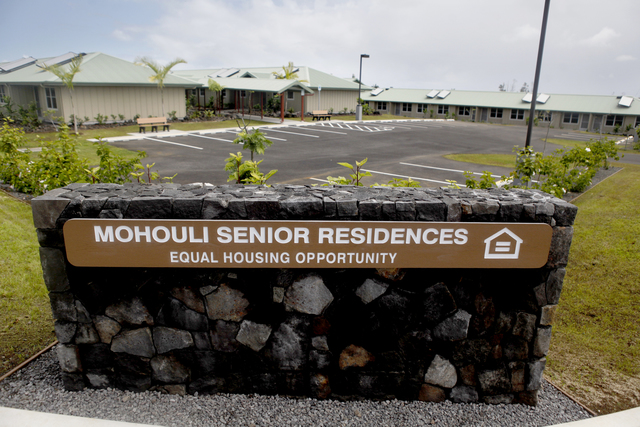With the approval of a host of federally funded projects intended to improve housing conditions for lower-income families, Hawaii County and its nonprofit partners are continuing a long march to universal affordable housing on the Big Island. ADVERTISING With the
With the approval of a host of federally funded projects intended to improve housing conditions for lower-income families, Hawaii County and its nonprofit partners are continuing a long march to universal affordable housing on the Big Island.
The county Office of Housing and Community Development will work with several agencies for its upcoming initiatives, including Hope Services Hawaii and Child &Family Services, but its main partner when it comes to housing is the Hawaii Island Community Development Corp.
HICDC’s task is straightforward but Sisyphian: In spite of a decades-long effort that increased the number of rental units on the Big Island and helped hundreds of families into their first homes, demand for programs shows few signs of decreasing.
“It’s hard for me to say how it’s changed — there’s always been a big need,” said HICDC executive director Keith Kato, who has been with the organization since 1996. “It seems to be there in perpetuity.”
“That’s kind of high on everybody’s list — affordable housing,” county Housing and Community Development specialist Noel Fujimoto said.
Fujimoto recently completed the county’s five-year consolidated plan, a survey of community needs and goals that is submitted to the federal Department of Housing and Urban Development (HUD) in order to receive funding from the Community Development Block Grant and HOME programs. The No. 1 priority listed in the plan is housing.
According to the consolidated plan, there are 6,074 families on the county’s Section 8 wait list. As of December 2014, 1,723 households were being assisted by the federal program, which provides vouchers for rental housing assistance (data on single-person households is not collected by the county).
But the need extends to both homes and rentals, Fujimoto said. According to HUD, “affordable” means that households should spend no more than 30 percent of their income on the costs of a housing unit, whether in the form of rent or mortgage.
“Even though the price of owning a home is lower here than any place else in the state, it’s still high,” Fujimoto said. “(And) you have to qualify for a mortgage, so affordable rentals is a need.”
Programs like CDBG and HOME are major resources for funding both types of housing. When financing projects, Kato also seeks funding from the state Legislature as well as private foundations and individual donors.
The county receives approximately $2.5 million annually for CDBG projects.
The funds have broad use, Fujimoto said, and can be used for “just about any type of project” outside of new construction. This year, the funds go toward eight projects, including housing rehabilitation, renovation of rental units for seniors, and rental assistance (similar to Section 8).
A West Hawaii pilot program to build transitional housing for the chronic homeless by re-fitting shipping containers into micro-units, completely with bathrooms, is also set to receive money.
The county approved six projects for HOME funds, including the second phase of construction at Mouhouli Neighborhood Heights, a senior rentals facility. It will be the eighth senior rental project completed by HICDC, and is scheduled to break ground in January of next year.
“They … have a waiting list all over the island for seniors,” Fujimoto said. “The baby boomers are all becoming senior citizens.”
Kato said he is also working to secure state money for the project in addition to the federal HOME funds.
HOME funds are distributed to the state, which in turn disperses them among Hawaii, Kauai and Maui counties. In 2012, the state changed its distribution method so that each county gets funded (typically in the range of the annual CDBG disbursement) just once every three years instead of annually.
“This year was our turn to receive the funding,” Fujimoto said. “We won’t receive more until 2018.”
Deciding how to allocate the resources and account for future projects “takes quite a bit of planning,” he said. “We have to work with the nonprofits throughout the island to find out what (their) projects are.”
Because HOME funds can be used for new construction, they are a crucial element in HICDC’s self-help housing programs, which involve building several homes at a time, with the future homeowners working together on the entire subdivision. More than 290 homes have been built to date; the HICDC’s most recent initiative, 10 new homes in Hawaiian Paradise Park, is just getting underway.
“All the families work together, everybody works on everybody else’s homes,” Kato said. “Nobody moves in until all are complete.”
Families receive mortgages through a U.S. Department of Agriculture loan program, but the loans don’t always stretch far enough.
“Not every family qualifies for enough money, so the HOME funds fill the gaps,” Kato said.
Though financing affordable housing is a constant challenge, a bigger struggle tends to be finding sites to build on in the first place.
“We need to make sure over the long haul there’s enough resources … to build enough houses that people can afford, things like developable sites and access to infrastructure,” Kato said. “If we can get a piece of property, eventually we’ll be able to put the financing together.”




